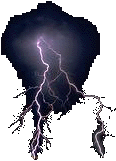 |
 |
 |
 |
| About me... |
| D3M0niQ |
| 7 SEGMENT LED DISPLAY |
| As the name implies, optoelectronic devices produce light or use light in their operation. The first optoelectronic device was the light-emitting diode (LED). It has a longer lifespan than the fragile incandescent light bulbs used to indicate on/off conditions on panels. When forward biased, an LED produces visible light which may be red, green, or amber, depending upon the material it is made of. There are two types of LEDs: �common-anode� and �common-cathode�. So what's the difference between them? In a common-anode configuration, all the anodes of the LEDs are tied to a single +V input, as shown in Figure(a). Each cathode is connected to the relevant output pin of the BCD to 7-segment decoder (74LS47). Individual LEDs are lit by applying a ground to the appropriate cathode. In a common-cathode configuration, all the cathodes of the LEDs are tied together, as shown in Figure (b). The individual LEDs are lit by applying a high voltage (between +5 to +10 V) to the appropriate cathode. Note that for both cases, each LED must have its own series current limiting resistor. |
| BCD TO 7-SEGMENT DECODER, 74LS47 |
| Pin Number - Description 1 - BCD B Input 2 - BCD C Input 3 - Lamp Test 4 - RB Output 5 - RB Input 6 - BCD D Input (unused;tie to GND) 7 - BCD A Input 8 - Ground 9 - 7-Segment e Output 10 - 7-Segment d Output 11 - 7-Segment c Output 12 - 7-Segment b Output 13 - 7-Segment a Output 14 - 7-Segment g Output 15 - 7-Segment f Output 16 - Positive Supply BCD to 7-segment decoder accepts the BCD code on its inputs and provides outputs to drive a common-anode 7-segment display to produce a decimal readout, as shown below. |
 |
| SOURCES |







